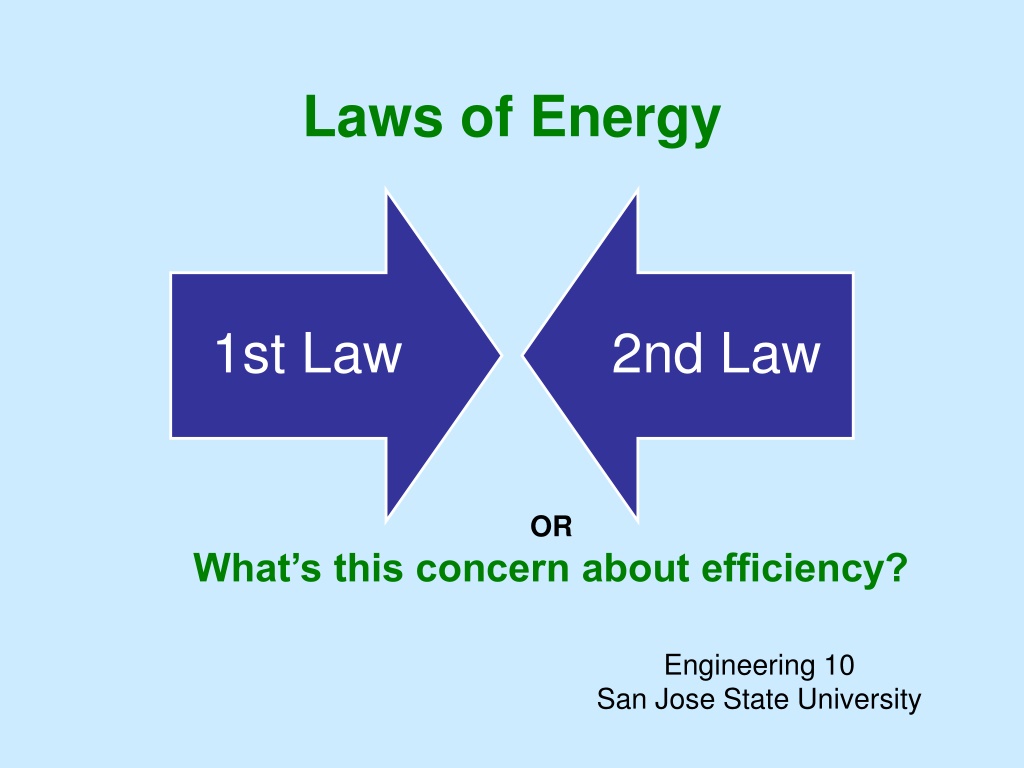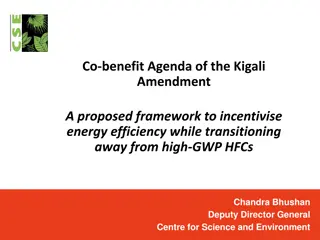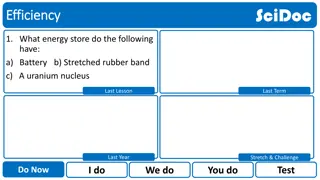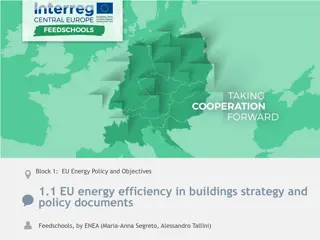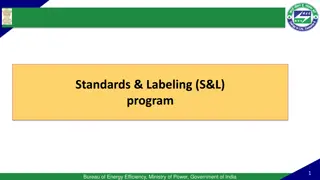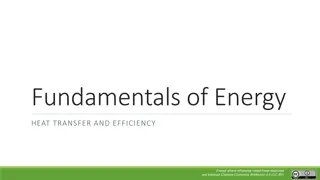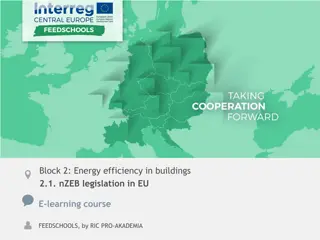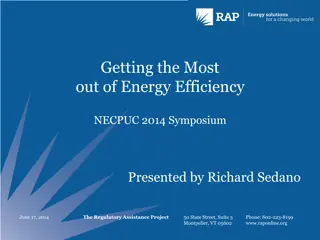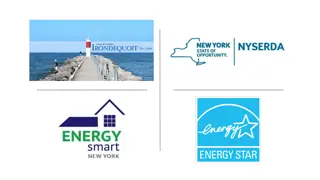Understanding Energy Laws and Efficiency in Engineering
The laws of energy, such as the 1st and 2nd Laws, are fundamental concepts in engineering, focusing on power sourcing, energy receiving, and conversion. Efficiency plays a crucial role in energy transformation. Concepts like force, speed, voltage, and current are key in understanding the rate of energy transmission. Various scenarios test understanding, such as calculating energy usage when pushing an out-of-gas car. Efficiency considerations are vital when analyzing energy input and output, particularly in systems involving motors and solar panels.
Download Presentation

Please find below an Image/Link to download the presentation.
The content on the website is provided AS IS for your information and personal use only. It may not be sold, licensed, or shared on other websites without obtaining consent from the author. Download presentation by click this link. If you encounter any issues during the download, it is possible that the publisher has removed the file from their server.
E N D
Presentation Transcript
Laws of Energy 1st Law 2nd Law OR What s this concern about efficiency? Engineering 10 San Jose State University
Review: Power Sourcing Energy Receiving Energy Energy conversion Force, Speed, Voltage, Current, etc. The rate of energy transformation or transmission (i.e. power) is related to the physical quantities such as force, speed, voltage, current, etc. (c) P.Hsu 2009
Force (Newton) Speed (m/s) For mechanical system, rate of energy transfer to an object is the product of the force (F in Newton) and the speed (S in meter/sec) in the direction of the force. Power = F x S (c) P.Hsu 2009
Convince Yourself Power = Work/Time Work = Force X Distance Power = Force X Distance/Time Power = Force X Speed (N m/s) (c) P.Hsu 2009
Clicker Question A person pushes an out-of-gas car with a force of 100 Newton (about 22.5 lb of force) to maintain a speed of 0.2 m/s. It took him 10 minutes to get to the nearest gas station. How much energy did this person use to do this work? (Hint: Power = Force x Speed) (A) 20 J (B) 600 J (C)1200 J (D) 2400 J (E) 12000 J (c) P.Hsu 2009
F S = speed Wind Current (I) Power = 3*F*S Voltage (V) Power= V*I If the system is 100% efficient, Power = 3*F*S = V*I (c) P.Hsu 2009
1000psi PUMP Rate of energy input = P (J/S) Current (I) Power Out + Voltage (V) - Speed = S Motor Solar Panel Force = F Assuming solar panel s efficiency is 15% and the motor efficiency is 80%, the combined efficiency is about 12%. Power Out = F*S = 0.15 * 0.8 * P = 0.12 * P (c) P.Hsu 2009
If force and speed are constant, power is constant. In this case, the amount of work (or the amount of energy converted) over a period of T seconds is Work (J) = Power (J/s or W) x T (s) = F (N) S (m/s) T (s) = F(N) x D (m) (where D is the travel distance) D F F (c) P.Hsu 2009
A person pushes an out-of-gas car with a force of 100 Newton (about 22.5 lb of force) to maintain a constant speed. The nearest gas station is 120 meters away. How much Work does this person has to do to push the car to the gas station? Work = Force x Distance = 100 (N) x 120 (m) = 12000 (J) D F F (c) P.Hsu 2009
1000psi PUMP Clicker Question How much work is done to lift a weight of 10kg by 10 meter? Hint: Gravitational force on the weight is F=10kg *9.81 (A) 981 J (B) 981 W (C) 981 Newton (D) 981 Volts (E) 981 Amps Motor Force =10*g (c) P.Hsu 2009
Forms of Energy Macroscopic Energy: Kinetic energy, potential energy, magnetic, electric, etc. Microscopic Energy: Molecular kinetic energy (particle motion at molecular and atomic level). Energy associated with binding forces on a molecular level, atomic level, and nucleus level. (Energy from burning fuel, atomic, and nuclear energy).
Molecular kinetic energy It is an Internal Energy . Due to molecular translation, vibration, rotation, electron translation & spin. Temperature is a measure of this energy When heat is added to a mass, the molecular kinetic energy is increased. This energy increase can often be related to the temperature increase ( T) by the following equation. Added Energy = Increase of molecular energy = T x M x Cp where T is in Celsius, M (mass) is in gram, and Cp is the Specific Heat constant of the material.
Some Common Specific Heat Material Specific heat (J/oCg) Air Aluminum Copper Gold Iron Mercury Water 1.01 0.902 0.385 0.129 0.450 0.140 4.179 Example: It takes 0.385 Joules of energy to raise 1 gram of copper 1 degree Celsius. Example: Raising 1kg of copper 5 degree Celsius requires: 0.385 x 1000 x 5 = 1925 J
Total Energy of a System (System = One or more objects, including gas) Total energy of a system is the sum of its macroscopic energy and microscopic energy. For simplicity, we only consider three forms of energy here: Total Energy = KE + PE + U Macroscopic Microscopic (internal) KE: Kinetic Energy, PE: Potential Energy U: Molecular kinetic energy (an internal energy)
The First Law of Thermodynamics (Conservation of Energy) Energy cannot be destroyed or created. It only changes from one form to another form.
Gas, air Exhaust gas From 1st Law of Thermodynamics, Energy Input (Qin) Heat in the exhaust (Q1) Qin=Q1+Q2+Q3+Q4 Heat in the engine and other car parts (Q2) In this example, the efficiency of the system is Overcome air and road resistance (Q3) Q Efficiency= 4 Car s kinetic and potential energy (Q4) Q in 0 mph 50 mph
The First Law of Thermodynamics (Conservation of Energy) From the 1st law of Thermodynamics, for a system Energy In Energy Out = The system s total energy change (Recall that Total Energy = KE + PE + U
Example: In a well insulated chamber, a steel block of mass m1 is dropped on a steel plate of mass m2. Find the temperature change of the masses, if any. Answer: This system does not have input or output energy and therefore the system s total energy reminds the same. 0 Before: Total Energy = KE + PE + U ; ( Potential + Internal ) 0 0 After: Total Energy = KE+ PE + U + U; (Internal + change ) Since total energy is unchanged, m1 PE = U Solve the following equation for T. T+ T T h m2 = + ( Cp ) m gh T m m 1 1 2 Before After
m1 Group Problem T+ T T h Form group of 2 or 3 put name and SID on paper Block A, a 10kg block of aluminum is suspended 2 meters directly above an identical block, Block B. These two blocks are both in a thermally insulated enclosure in which air is completely evacuated. If the temperature of both blocks is initially 25 C, what is the temperature of the blocks after the Block A is dropped on Block B below it? m2 Aluminum 0.902J/Cg (c) P.Hsu 2009
Energy in or out of a system can be in the form of 1. Heat transfer: Heat the system up (in) or cool it down (out) Fire 2. Mechanical work: Apply force to the system and cause a motion i.e. W=F*D (energy-in) or the system applies a force to an external object and causes motion (energy-out) W=Force x D
The 1st law of Thermodynamics Energy In Energy Out = Total Energy Change W=Force x D When a volume of gas is compressed in a cylinder (energy-in) the gas temperature is increased (energy change) by an amount that is proportional to the work done W. Gas W=Force x D When the gas in a cylinder is heated up by fire. The energy from the heat (energy-in) results in (1) increase gas temperature (energy change) and (2) mechanical work done by the piston. (energy out) Gas Fire
Efficiency <1 Since the first law of thermodynamics says the energy output cannot exceed the energy input (energy is conserved) Output energy Input energy 1 Efficiency = (c) P.Hsu 2009
Clicker Question When a volume of gas is compressed, (A) Its temperature goes up. (B) Its temperature goes down. (C) Its internal energy remains unchanged. (D) Work is performed by the gas (c) P.Hsu 2009
The Second Law of Thermodynamics Expression of the tendency that over time, differences in temperature, pressure, and chemical potential equilibrate in an isolated system. (Wikipedia) The second law tells us that energy transformation processes in an isolated system must occur in a certain direction. For example, heat travels from hot to cold.
A Point to think about If a behavior does not violate any physical law, it is possible. Neither one of the following behaviors violates the First Law of Thermodynamics since the total energy is the same before and after the process. HOT water COLD water WARM water WARM water HOT water COLD water The 2nd behavior is not possible for an isolated system.
Is it possible to build a car that runs entirely on the energy extracted from the ambient air? With Energy Extracting Engine! No Fuel Ever Needed! Cold Air out Warm Air in This is impossible according to the Second Law of Thermodynamics. You will learn more about this in your future physics and engineering classes! based on notes of P. Hsu 2007
When a volume of gas is compressed, its temperature goes up. This is true because which of the following physic law (A) Newton s Law (B) Ohm s Law (C) First Law of Thermodynamics (D) Second Law of Thermodynamics (c) P.Hsu 2009
Heat Engine (example: car engine) It is possible to design a machine that takes the energy from a heat source and transforms it to mechanical work. Such machine is called Heat Engine . The theory of operation of this machine cannot violate the laws of thermodynamics, of course. Wout Wout Win Low Temp Qout Qin Qin High Temp High Temp Wout is the work performed by the gas and Win is the work performed to the gas due to, for example, the rotational kinetic energy of the wheel. For the engine to do work, we need Wout > Win. (c) P.Hsu 2009
Wout Wout Win Low Temp Region Qout Qin Qin High Temp Region High Temp Region Mechanical work out Total Heat Energy in Temperature of the cold side 1 Temperature of the hot side = Best Theoretical Efficiency = Note that higher efficiency can be obtained with higher temperature difference between the hot side and the cold side. (c) P.Hsu 2009
Heat Flow Diagram High Temp. Qin Heat Engine needs a high temperature (energy source) and a low temperature (energy sink). Heat Engine Work Mechanical work is performed as heat flowing from the high temperature side to the low temperature side. Qout Low Temp. (c) P.Hsu 2009
Which one of the following statement best describes the Second Law of Thermodynamics (A) Energy cannot be created or destroyed. (B) Some form of energy is more useful than others. (C) There is no free energy. (D) Efficiency of any system cannot be greater than 1. (c) P.Hsu 2009
For a heat engine to work, which of the following item is required? A.Piston, spark plug, and cylinder B.Electric current and voltage C.High temperature source and low temperature sink D.Oil and gas E.Fuel and combustion
